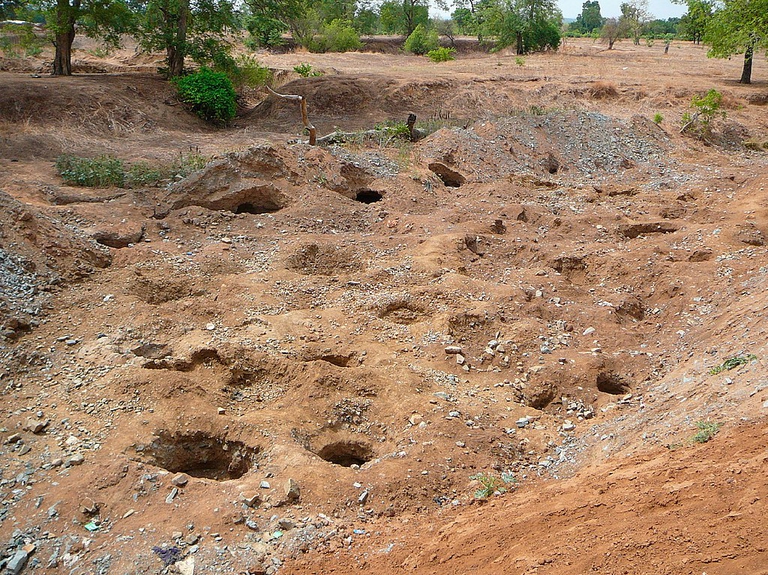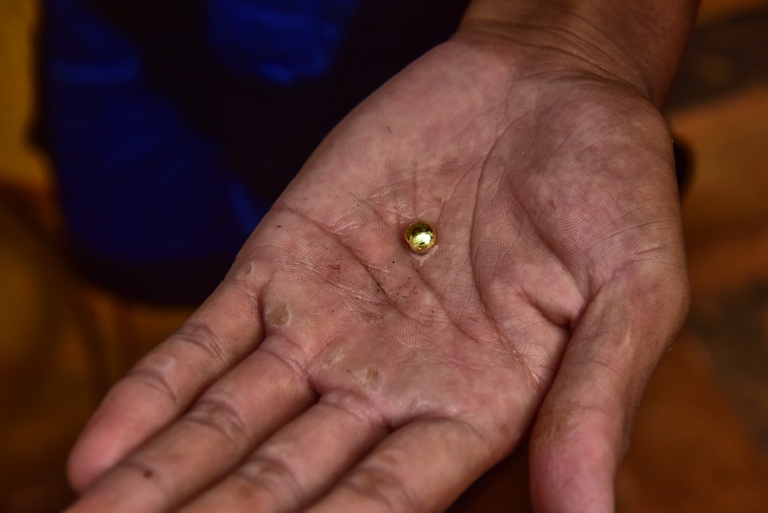
Sharon Lavigne, one of the six winners of the 2021 Goldman Environmental Prize, is fighting to protect her community from plastics corporations.
The livelihood of millions depends on artisanal and small-scale mining (ASM), especially in Sub-Sarahan Africa. Yet this practice comes at a significant environmental and human cost.
Artisanal and small-scale mining (ASM) provides jobs to 13 million people in 80 countries worldwide, numbers that resemble those of large-scale mining. Whilst the latter is often undertaken by big companies, requires a substantial labour force and operations continue until sites ares completely excavated, ASM on the other hand is carried out by small groups who travel around to identify sites where they believe precious minerals or metals can be found. It accounts for 20 per cent of global gold supply, 80 per cent of sapphire, 20 per cent of diamond supply and 25 per cent of overall tin extraction, and provides essential minerals used in popular electronics such as phones or laptops. In 23 Sub-Saharan African countries, it is an important source of revenue for people living in rural contexts, where it is largely carried out as an informal and often illegal activity (for example, around 40-50 per cent of small-scale miners work illegally in Ghana). Yet its benefits are often outweighed by its costs.
The relative absence of legislation and government controls in African countries make the environmental impacts of ASM arguably on a par or worse than those of large-scale mines. These include mining in protected areas or the dumping of effluents into pristine ecosystems. Furthermore, communities around mining sites don’t have the infrastructure to deal with waste, with dire impacts on hygienic and health conditions. Other important environmental concerns associated with ASM include land degradation, deforestation and loss of biodiversity.
Gold mining, widely practiced in Sub-Saharan Africa, presents additional problems. Mercury is used to separate gold from the soil, it is dissolved to extract the precious metal and thus dispersed into the air, which workers breathe in during operations. The remaining vapour then either settles into the ground, contaminating soil and waterways, or travels long distances in its gaseous form and eventually precipitates as rain. This process creates mercury “hotspots” in places far away from mining sites, as well as a series of other cascading effects: where mercury deposits into water sediments, bacteria transform it into methylmercury, which is easily absorbed by worms, snails and insects. The contamination then travels up the food chain, eventually returning to humans. For example, consuming contaminated fish generates health risks in people living downstream of mining areas. Mercury’s long-term effects include memory or motor-function loss, kidney malfunction, acute anaemia and respiratory diseases.
As well as the inhalation of toxic gases such as mercury and the fumes from explosive blasts, which can become lethal when combined with poorly ventilated environments, ASM-related accidents occur due to inadequate working conditions and equipment. A study shows that the Busia mining district in Tanzania experiences one to five deaths annually, and another looking at accidents and injuries in Ghana finds that fatality rates are 90 times higher than in large-scale mines. Collapse of mine pits, explosive blasts and falls respectively account for 13, 10 and 5 per cent of total incidents, with almost 3 per cent of these injuries resulting in death: seeing as the research is focused on individuals in hospitals, the authors acknowledge that most injuries are dealt with in private, meaning that the number of affected people is possibly much higher.
Mining communities form rapidly whenever and wherever minerals are found. These temporary establishments are usually informal, which means that they don’t qualify to become the recipients of healthcare services. This is a serious issue for miners given the dangerous nature of their job. In addition, crime, prostitution and sexually transmitted diseases are rife in these communities. “Whenever there’s mining, there’s money,” says Doctor Penda Diallo of the University of Exeter’s Camborne School of Mines in southwest England.
Especially in developing countries across Sub-Saharan Africa this “can fuel conflict and disagreement,” says the lecturer and researcher specialised in sustainability in the extractive sector and the politics and governance of ASM. This can potentially lead to crime, especially among young people, for example in relation to the “high value of gold from gold mining”. Comparing this to jewellery shops, she explains that “shops don’t leave jewellery overnight to avoid attracting criminals because whenever there are high value items, it’s likely to find people wanting to steal them”. Diallo also notes that there’s a high occurrence of prostitution around gold mines because “men are away from their families for a long time”. She adds that these illicit activities also depend on area-specific as well as the country-specific dynamics.
Most coverage focuses on the ills of small-scale mining, with few attempts to understand why such problems come about. It’s important to consider that for many individuals this activity is the only opportunity for employment, which in turn can bring social and economic development. There are other advantages to small-scale mining: often it is carried out through local enterprises, which means that individuals don’t need to move far from home to work. It can also be integrated with other types of labour such as farming: mining can occur in the dry season, complemented by farming in the rainy season. This gives individuals more flexibility in their jobs, and helps them maintain a relatively stable lifestyle.
In Guinea alone, artisanal and small-scale mining revenues account for almost 16 per cent of expenditure on health, education, water and infrastructure development, 80 per cent of export revenues and 20 per cent of the national GDP. Despite the massive potential of the industry, ASM remains at the periphery of poverty alleviation strategies and development policies.
According to Diallo, the high prevalence of illegal mining occurs because there are “too many sites that are cumulatively not easy to control”. This is exacerbated by the nomadic nature of the activity that happens because people “move to new establishments based on where minerals are found”. “Mining needs to be formalised“, i.e. regulated through legal and policy frameworks, to deal with this problem, so that the government “knows where and how mining is happening”. Suitable training and education can then be delivered to miners. Following this, “incentives need to be given to workers so that they implement and maintain their training when mining”. An example of this could be tax deductions that motivate individuals to use the knowledge derived from their training in practice. “This needs to be coupled with on-site monitoring,” Diallo adds. However, the “limited capacity of governments” results in an activity that is hard to control and improve.
Regulating ASM would also mean reducing the environmental impacts of the activity. A research paper focused on this aspect using Ghana as a case study suggests adopting moral suasion (education, publicity and social pressure), legal enforcement and fundraising to provide efficient machinery or more sustainable processing techniques. The researchers also suggest a series of mitigation measures, which include the reclamation of lands by reforesting mined areas. This was done successfully in the Ablorman, Nueng Forest Reserve and Buadua areas in Ghana.
In addition, some NGOs have emerged over time, offering guidance to miners and mining communities. For example, Conadog in Guinea manages mineral-related conflicts by supporting social cohesion in solving disputes and is based within mining sites, meaning that its action is both preventative and curative. NGOs like this give hope that some action can be taken to improve the impacts of ASM. For mining will persist as long as there’s demand for minerals, so it’s time for governments and individuals to take action in protecting the rights of natural environments and the humans residing in them.
Siamo anche su WhatsApp. Segui il canale ufficiale LifeGate per restare aggiornata, aggiornato sulle ultime notizie e sulle nostre attività.
![]()
Quest'opera è distribuita con Licenza Creative Commons Attribuzione - Non commerciale - Non opere derivate 4.0 Internazionale.
Sharon Lavigne, one of the six winners of the 2021 Goldman Environmental Prize, is fighting to protect her community from plastics corporations.
Plastic pollution is airborne too. Microplastics are being carried across continents by the wind, as a recent study reveals.
Levels of particulates in New Delhi in 2020 were once again far above safety thresholds, with extremely serious health consequences for its citizens.
A major oil spill in the Ecuadorian Amazon in April has left the Coca River polluted. The indigenous Kichwa are suing the companies whose pipelines broke.
Molecules that eat up plastic waste, including PET bottles, may soon become widely used as scientists leap ahead in developing new super enzymes.
In Italy’s Land of Fires between Naples and Caserta, activists like Carmen Medaglia are fighting to promote new ways of managing waste.
Toxic substances in Kamchatka’s waters have killed 95% of marine fauna and caused health problems for surfers. The causes, however, are still unknown.
A Magellanic penguin was found lifeless on a Brazilian beach: in its stomach, an N95 face mask. Researchers believe the animal died from ingesting it.
The drop in air pollution during worldwide lockdowns helped prevent thousands of premature deaths. But the situation is returning to pre-crisis levels.











